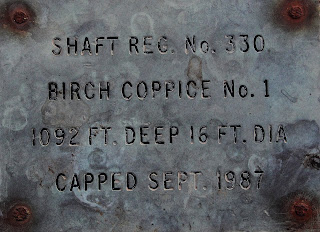Saturday, 26 January 2013
Worked Out
As we reach Worked Out, the third song on English Electric Part Two, we have moved from the shipbuilders of the North East (see David's blog on Swan Hunter) back to the mining industry of the Midlands (which featured as a setting in Uncle Jack, Hedgerow and A Boy in Darkness on Part One).
It is difficult to contemplate the immense scale of coal mining in Britain before its relatively recent decline. In the 1920's, there were more than a million coal-miners and the number was still at around 700,000 into the 1950's. By 1994, there were just 20,000 coal-miners.
The loss of so many mines was a disaster for communities which relied on the industry for work. Some have recovered but others still suffer very low levels of employment with all of the problems that lack of work brings.
Worked Out tells the story of a community from a mine which lasted longer than most. The colliery was called Birch Coppice and mined the Warwickshire coalfield until 1987. In the end, the colliery was closed because of a faultline in the coalface rather than for political or economic reasons.
My parents live in Tamworth and rent some storage on a farm near Birch Coppice. I spent a fair bit of time in the late 80's and early 90's wandering around on the land around the farm which was becoming 'edgeland'. Above the farm loomed a huge man-made hill where the spoil from the mine had accumulated. Nature was reclaiming the site and the hill was greening over. In a cutting I found the track bed of a disused railway line (heaven!) and, surrounding it, the remains of industrial workings. In more recent years, much of the site has been cleared and has become a modern distribution centre but there are still large areas of encroaching wilderness.
And, in any case, it is what lies beneath that really interests me. Underneath the ground are the remains from over 150 years of mining. There are shafts (now capped) which reach depths of over 1000 feet. There are 18 miles of workings and passages and the farthest coal face was three miles from the shafts. It was a huge undertaking and all of the visible remains were disappearing back into the undergrowth (or were being buried by car parks and warehouses.)
The same type of story can be found in the landscape all over Britain as the physical remnants of the gigantic undertaking that was the Industrial Revolution are lost. Worked Out is a song about the miners of Birch Coppice but it could be about any of the mining communities which have seen the closure of the pits and the loss of a way of life.
Monday, 14 January 2013
East Coast Racer
 |
| Photo: Gresley Society Trust |
We are now seven weeks away from the release of English Electric Part Two, and as with Part One, we will be posting a weekly blog about the songs on the album up until the date of release.
The first song on Part Two is called East Coast Racer.
75 years ago, on 3rd July 1938, a streamlined locomotive called Mallard set the world speed record for steam trains, travelling at 126mph on a straight, downhill stretch of the East Coast Mainline.
Mallard has been preserved as a static exhibit and is normally on display at the National Railway Museum in York. Whilst she was made for speed the designers created a machine of extraordinary beauty; if you go to the museum, she will stop you in your tracks.
The story of Mallard has been described by Andrew Martin as being like Chariots of Fire with steam engines and it became, for me, an irresistible theme for a song. However, it wasn't so much Mallard but the people who designed, made, fired and drove her that interested me. And it is their tale we tell over the 15 minutes or so of East Coast Racer.
It is a story with a wonderful list of main characters; designer Sir Nigel Gresley, his assistant Oliver Bulleid, fireman Tommy Bray and driver Joe Duddington. Alongside those with starring roles was a community of engineers and railwaymen who all played a part in the making of a legend.
But, in the end, we come back to Mallard.
Émile Zola said: 'Somewhere in the course of manufacture, a hammer blow or a deft mechanic's hand imparts to a locomotive a soul of its own'.
In this short sentence, Zola puts his finger on the connection between the maker and the machine. Mallard has outlived its creators but in it, this company of men and the work they carried out, lives on.
Subscribe to:
Comments (Atom)


